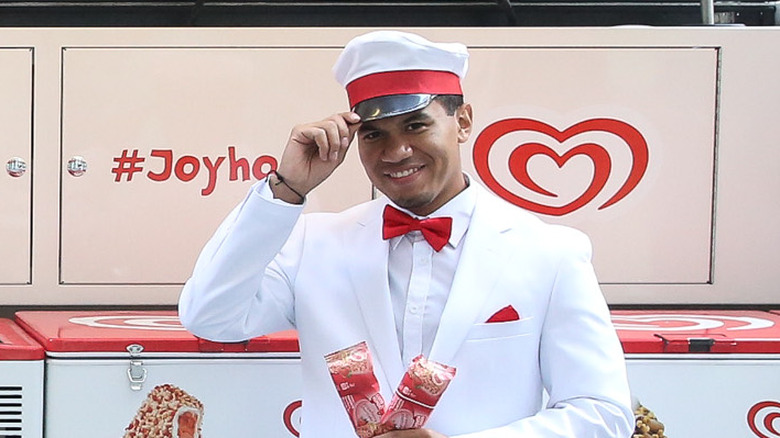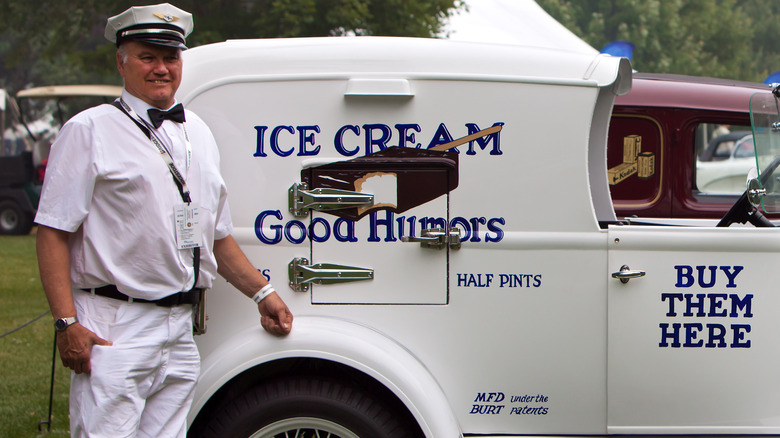The Nostalgic Origins Of The First Ever Ice Cream Truck Jingle
There are certain aspects of the classic ice cream truck, and the experience of buying a prepackaged frozen treat or piled-high cone, that it's impossible to imagine the whole scenario without them. There's that poster displaying the ice cream treats on offer, a driver dressed in garments as white as the truck itself, and amplified music box-type music. The songs played by an approaching ice cream truck are always a familiar and wordless tune, likely something straight out of the 1800s vaudeville or minstrel show circuit, like "The Entertainer," "Camptown Races," "Oh! Susanna," or "Turkey in the Straw" (or its even jauntier cousin, "Do Your Ears Hang Low?")
Like everything else that feels like it's been around forever, ice cream truck music had to start somewhere, and it all goes back to the idea of one guy with one truck. Historians have traced the idea of vehicles selling ice cream while cranking out kid-friendly music — one of the earliest examples of an advertising jingle — back to one ambitious treat vendor.
Before they played music, ice cream truck drivers rang bells
The ice cream truck emerged after its pioneering practitioner invented the chocolate-covered ice cream bar — the Good Humor bar, according to Good Humor. In 1920, in Youngstown, Ohio, candy maker Harry Burt came up with a chocolate that would solidify around ice cream, and he formed it into bars on sticks upon the suggestion of his son, per Good Humor. Burt named it the Good Humor bar, bought a dozen trucks, installed freezers, and sent out drivers to move about town and sell ice cream as a mobile operation.
That brought modern technology to the ice cream sales game, instantly transforming the industry, according to Smithsonian Magazine. Up to that point, mobile ice cream sellers pushed around wooden carts full of ice cream confections. To draw attention, Burt had his drivers ring sleigh bells, a concept with which no one was familiar. He got the idea from the sleigh bells he saw on his son's sled. The whole operation — including announcing the presence of an ice cream vendor with the warm sound of nostalgia-invoking bells — worked out quite well. By the 1930s, franchisees operated Good Humor trucks around the U.S. and were selling millions of bars each year, per Smithsonian Magazine.
The first ice cream song is based on an old Czech tune
Sleighbells became standard operating procedure for Good Humor trucks until 1929, when, according to Smithsonian Magazine, Los Angeles-based Good Humor franchisee Paul Hawkins decided to ditch the bells in favor of amplified, pre-recorded music. With the reasonable assistance of organ builder Louis Bacigalupi, Hawkins installed a mechanized music box in his ice cream truck, near the engine, which repeatedly played a nine-second instrumental snippet of "Stodola Pumpa," a Czech folk song, per Smithsonian. Rather than having to ring bells whenever he or a driver stopped, Hawkins could just let the tune play all day, and let it announce his eventual arrival at every stop along the route. The automated music box, playing a folk song all the time, would become a tool of virtually all ice cream truck operators, both for Good Humor and its competitors.
The song later was often performed at children's summer camps and YWCA events, per Smithsonian. "Stodola Pumpa" further embedded itself in California culture, with The Beach Boys using it as the basis for the 1963 song, "The Rocking Surfer."


